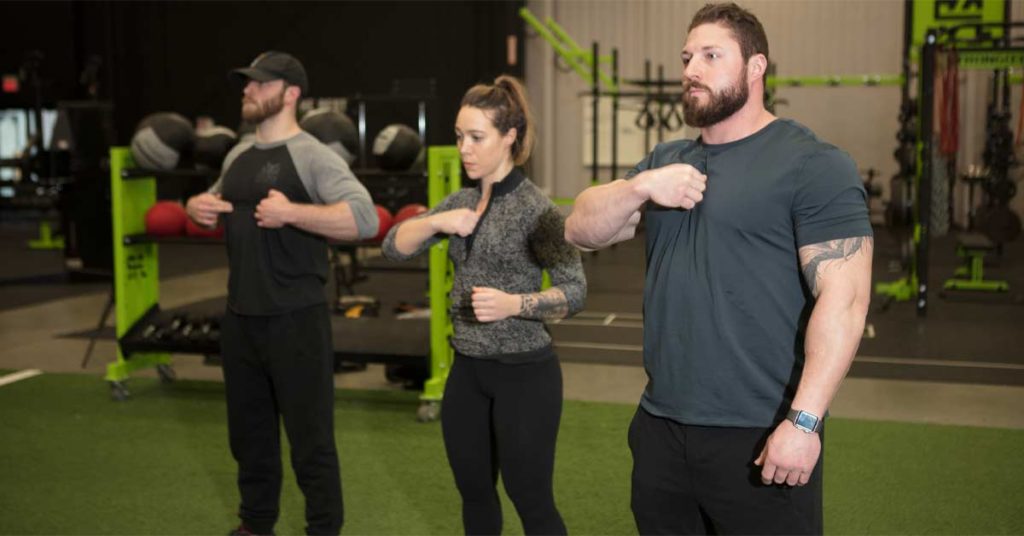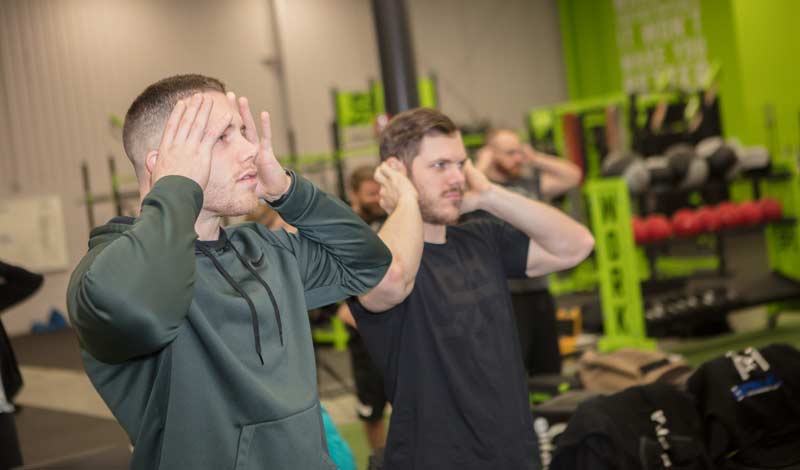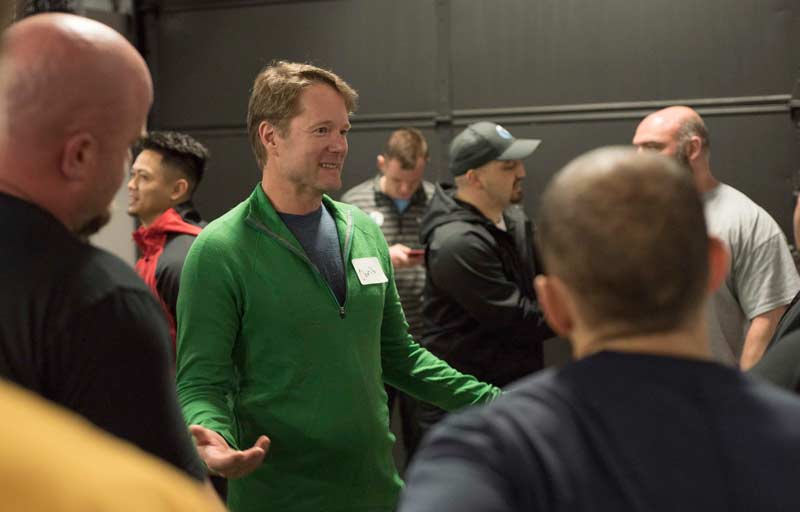
For those not familiar with it, Reflexive Performance Reset (RPR) is a simple system of breathing and tactile input that resets your body from a survival mode to a performance mode. Your body has two priorities: to breath and to move. In order to perform your best, you need to do both properly.
In a world of constant stress, our bodies find a way to meet those priorities by creating inefficient compensation patterns. In some cases, compensation patterns can limit performance and possibly lead to injuries. RPR Wake-Up Drills can help shift an athlete’s body out of these inefficient patterns and into efficient and powerful patterns to perform at their best, increase flexibility, and become more resilient to injury.
RPR Wake-Up Drills can help shift an athlete’s body out of inefficient patterns and into efficient and powerful patterns to perform at their best, says @korfist. Share on XSo, when you see your favorite team or players pushing or rubbing on different body parts, you will know they are “resetting” themselves for optimum performance. It was quite exciting to see both teams in the World Championships of women’s hockey on the ice performing their Wake-Up Drills as a team. It was also satisfying to walk through the warm-up area of the state championship meet, watching athletes in various stages of their “reset.”
But, like anything popular, effective, and simple…the process and message can get changed, and sometimes not for the better.
1. One Spot Needs One Reset
Too many times, people who don’t take the various courses just check online for someone showing a certain spot to reset a certain muscle. For example, if my knee hurts, I will do just the knee reset.
That can sometimes be effective for a short period of time, but it can also lead to a further compensation pattern or continued poor performance. Why? Part of the magic of RPR is the sequence of the Wake-Up Drills. Just like turning on a computer, there has to be a sequence of events to “boot” up. If something in the sequence does not start, all kinds of things may go wrong with your computer. The same can happen when our body goes to recruit muscles for a contraction. If a muscle isn’t getting the signal, other muscles will step in to compensate for that muscle so the movement can take place safely (but not always efficiently).

The sequence of the Wake-Up Drills is a reset to the recruitment sequence, thereby making sure that the muscle is ready to receive the message from the brain to work properly. The sequence also reminds the system of the proper recruitment pattern, so a glute can act like a glute and a hamstring can act like a hamstring. If a glute doesn’t want to start the chain of events, the hamstring will be asked to do two functions, which can lead to injury or a lack of performance.
2. Just Touching a Spot Doesn’t Have Any Impact
Our bodies respond to all kinds of input and stimuli. Think about the impact sunlight has on a body. Just five minutes looking toward the sun in the morning can set your entire circadian clock. Blue screens at night elicit a hormonal change. Injuring a toenail can change your gait instantly.
So why can’t touch create a change in the body?
The spots used for the Wake-Up Drills are tactile cues from human development. No one understands language when we are learning to crawl, but there has to be some cue that lets the body know it is ready to go. We tap into those cues to give primal input to the system to move. Plus, with RPR, you can instantly feel the change—which is why we have tests, so people can witness the change.
3. It’s Just for Athletes
RPR can be used by anyone, at any time. Since the three founders (Cal Dietz, JL Holdsworth, and I) are all athletic coaches, our intent was to bring a simple and fast method to empower our athletes by having them reset themselves with Wake-Up Drills to make sure they were at their best for practice or competition. It worked great with our athletes, and as other coaches started to expand the method’s use, we heard of all different athletes getting noteworthy results.
RPR can be used by anyone, at any time. It’s not just for athletes, says @korfist. Share on XFrom there, RPR expanded further, and we’ve heard positive feedback regarding:
- People in the work force performing manual labor.
- Special Forces experiencing benefits in the field.
- Babies experiencing changes from their caregiver’s use of the concepts.
- Seniors not only improving in the sport of golf but in their daily quality of life.
We have recently brought RPR breathing and Zone 1 resets to school districts, to help alleviate test anxiety and teach students to get their system ready to learn. This is one of the great benefits of RPR: It is a system that not only recognizes how the body works together physically (like the chain of muscles required in the recruitment process) but also ties the physical with the psychological.

RPR breathing can get the body in a performance state, so it can not only more readily take physical input but also calm the system so it can take mental input as well. It recognizes the fact that if the body is “off” in one of the categories, physical or psychological, it can also impede the progress of the other. For example, if I stub my toe, that pain will have an impact on the decisions I make. The RPR system helps link the two systems together so there can be one whole system on the same page.
4. You Only Have to Do It Once
Our body is constantly dealing with a variety of stressors. They can range from the physical to the emotional, psychological, and even environmental. With these constant “threats,” our body is always looking for the safest way to navigate this scenario. From an athletic standpoint, the body can down-regulate muscle activity for a variety of reasons, ranging from a conservation of energy standpoint (bigger muscles require more caloric intake) to safety (the brain doesn’t think the body can withstand the power output from a bigger muscle, so it cuts power).
The RPR Wake-Up Drills send a message to the brain that it doesn’t need to down-regulate and can let power flow. It is this concept that allows our flexibility to improve with the Wake-Up Drills. The brain will allow length when it feels safe—hence the lack of flexibility while injured, cold, or even scared. Once we reset, it gives the brain the cue that we can perform and give muscles their length. Hence, the first time you do RPR, you have this great sense of flexibility, power, and movement because it may have been the first time you have experienced this mental state in quite some time.
But “life” will happen again, and the body responds to those stressors and can shut down again. A simple solution: because RPR Wake-Up Drills don’t take long, you can simply reset yourself. The more you reset, the more it moves the needle to the middle of the performance/survival spectrum.
5. Someone Else Needs to Do It *to* You
RPR is unique in that it is a system that you can do on yourself. You don’t need a medical professional, coach, or teammate to do the Wake-Up Drills. It is all self-applied. With that said, RPR does not replace any technique or modality that you may currently employ. It just makes it all better, because you are giving the nervous system the cue to accept future input.
RPR is a system that you can do on yourself. You don’t need a medical professional, coach, or teammate to do the Wake-Up Drills, says @korfist. Share on XAlso, while it doesn’t cure preexisting injuries, it does put the body in a state to let it know it is time to heal and get muscles that may have been inhibited to work again so the healing can take place. In fact, we get an improved response because, most of the time, the brain never has been given the input that an injury has healed, and we keep the compensation that was developed as a result of the injury. This is where we see recurring injuries, like torn ACLs on the same leg or recurring ankle sprains.
If all of this interests you, please go to our website to check out more about RPR.
And we hope to see you soon at one of our in-person clinics.
Since you’re here…
…we have a small favor to ask. More people are reading SimpliFaster than ever, and each week we bring you compelling content from coaches, sport scientists, and physiotherapists who are devoted to building better athletes. Please take a moment to share the articles on social media, engage the authors with questions and comments below, and link to articles when appropriate if you have a blog or participate on forums of related topics. — SF


Ive learned on how to use RPR of finding the right spot or not the right spot.
I learned about how RPR can be used with everyone. RPR can expand with positive feedback. Our body is constantly dealing with a variety of stressors.